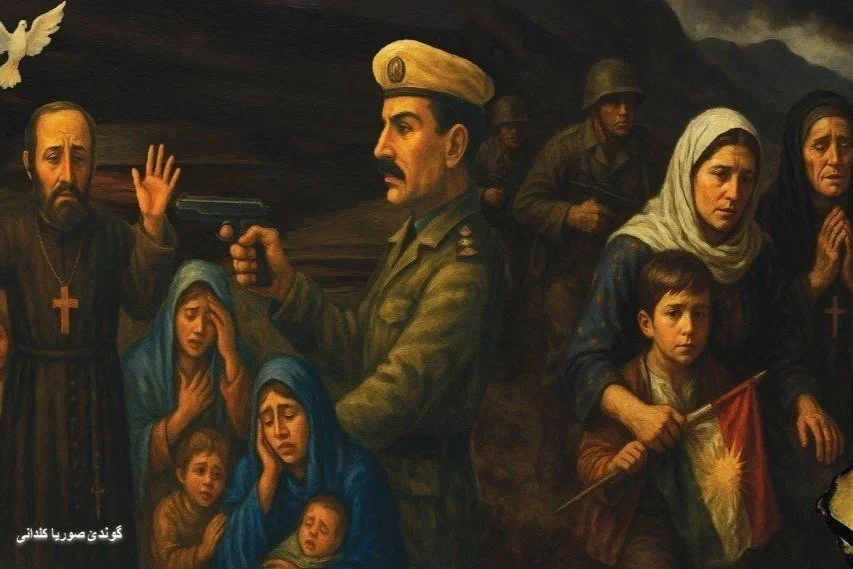Soria, 1969: A Village Crucified
Artwork by Mr. George Touma Esho.
A story of faith, sacrifice, and resilience
By Hanan Qia
Duhok – September 16, 2025
The Iraqi Chaldean community gathered in solemn remembrance of the tragic Soria Massacre of 1969, honoring the 39 innocent lives lost to a brutal military attack.
The event was organized by the Chaldean Democratic Union Party in cooperation with the Chaldean Diocese of Zakho, with the participation of local clergy, faithful from surrounding towns, and expatriates from the United States and Europe.
A Village in the Heart of the Borderlands
Nestled in the Slivani plain of Zakho District, just a few kilometers from Fishkhabour, on the left bank of the Tigris River at the border triangle of Iraq, Syria, and Turkey, the village of Soria was a small but vibrant Chaldean community.
About twenty families lived there, tending to their farms and livestock, carrying forward a simple life shaped by faith, tradition, and resilience.
Dawn of Tragedy
At dawn on September 16, 1969, a landmine detonated beneath an Iraqi military vehicle near the village, killing several soldiers. Within hours, a military unit led by Lieutenant Abdul Karim Khalil al-Juhaishi surrounded Soria.
Men, women, and children were herded into a nearby orchard. What followed was a horrific massacre: indiscriminate gunfire claimed nearly all lives, children hiding in a grain silo were executed, homes were burned, and belongings looted. In some cases, women’s fingers were severed to steal jewelry.
Father Hanna Qasha: A Shepherd Among His Flock
Amid this horror, Father Hanna Yaqub Qasha, the village priest, stood as a beacon of courage. Born in 1919 in Mosul to a family from Mar Yaqo near Duhok, he was ordained a priest in 1943 after studying at the Seminary of St. John. He had faithfully served several villages in the Zakho Diocese and frequently visited Soria to minister to his community.
On that fateful morning, Father Hanna had celebrated Mass and baptized a child. When the military surrounded the village, he stepped forward, raising his hand and speaking to the officer in an attempt to protect his parishioners: “Let us talk…” Before he could finish, a burst of gunfire struck him down.
His body, along with those of his parishioners, lay exposed under the sun for two days.
Finally, a villager from nearby Der Aboun retrieved Father Hanna’s remains and brought them to Zakho, where he was laid to rest in St. George’s Church in the Christian Quarter.
His martyrdom remains a profound symbol of a shepherd laying down his life for his flock, of faith confronting violence with courage, and of selfless devotion that transcends fear.
In total, 39 men, women, and children lost their lives that day. They were laid to rest in two mass graves near the village, their memory living on in the hearts of their community.
Soria: A Beacon of Resilience
More than half a century later, Soria, once a peaceful village in the Slivani plain, remains a painful scar in the history of Iraq’s Christian minorities. Yet, the blood of its martyrs has become a beacon of resilience and faith, inspiring future generations to preserve their roots, uphold their identity, and maintain their presence in the ancestral land despite adversity.

